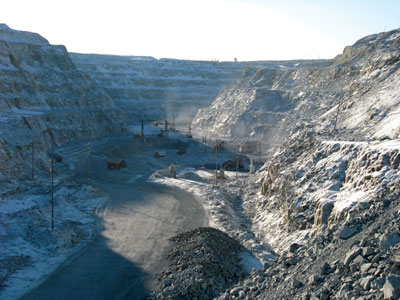 |
| Pit view of the Pioneer mine, which produced 314,850 oz of gold in 2013, representing 42% of U.K.-based Petropavlovsk’s full-year production and making it one of the largest gold mines in Russia. The mine is located in the Amur region, Russian Far East. (Photo courtesy of Petropavlovsk) |
Think of three factors that each might cause investors some unease: gold, Russia and debt. Then combine them into one package, and the reasons for the financial troubles at the second-largest gold producer in Russia, Petropavlovsk, begin to become clear.
In late February, shareholders approved a 157-for-10 rights issue that allowed the company to avoid default on $310 million in bonds that had become due for repayment. The downside, as far as they are concerned, is that their stake in the company has been significantly devalued, while Petropavlovsk still carries some $700 in net debt on its books.
Writing recently in the U.K. newspaper, The Independent, financial columnist Jim Armitage explained the background to the crisis, which had been brewing for some time. Essentially, gold at $1,200/oz cut the company’s ability to service debt taken on when the price was around $1,800, while more recent political events in Russia—the Ukraine situation in particular—had resulted in the financing well drying up.
By the beginning of this year, Petropavlovsk was carrying $922 million in net debt. When the plans for the rights issue plus a new $100 million convertible bond were announced, the company’s largest individual shareholder, Sapinda Holdings, returned to the offensive with counterproposals, citing its objection to the proposed dilution of shareholders’ interests. In the event, these did not meet with corporate favor, with Petropavlovsk’s chairman, Peter Hambro, warning investors that the alternative to accepting the deal was bankruptcy.
And that, of course, would have been another concern, not only from the financial perspective. Russia’s recent history shows a number of examples where foreign companies have run into financial difficulties, only to have their licenses revoked and then re-allocated to local interests. Sapinda’s ties with Russian investment and mineral companies only served to increase worries for Petropavlovsk’s investors, although Sapinda itself denied any intention to drive the company into bankruptcy and then mop up its assets.
In point of fact, those assets performed to expectations during 2014, producing 624,500 oz of gold at a total cash cost of less than $900/oz, the company reported. It predicts output this year will be 680,000–700,000 oz, net of alluvial production, with cash costs cut to less than $700/oz through cost cutting and the devaluation of the ruble against the dollar.
With its focus on securing the financing needed to repay its bonds, Petropavlovsk had not released its results for 2014 by early March. In the first half of the year, it reported a net loss of $95 million on revenues of $453 million, with a net loss during 2013 of $514 million after exceptionals.
Commenting on the refinancing, Hambro said, “2014 was a transformational year for the group, [but] our operational and exploration success has been overshadowed by a liquidity problem with the resulting uncertainty causing a sharp decline in our share price. Operationally, we believe the year has started well and we continue to build on our 2014 achievements.” With the company’s shares trading at around £0.05, having slid inexorably from more than £4 ($6.50) in 2010, that could be a good option.









